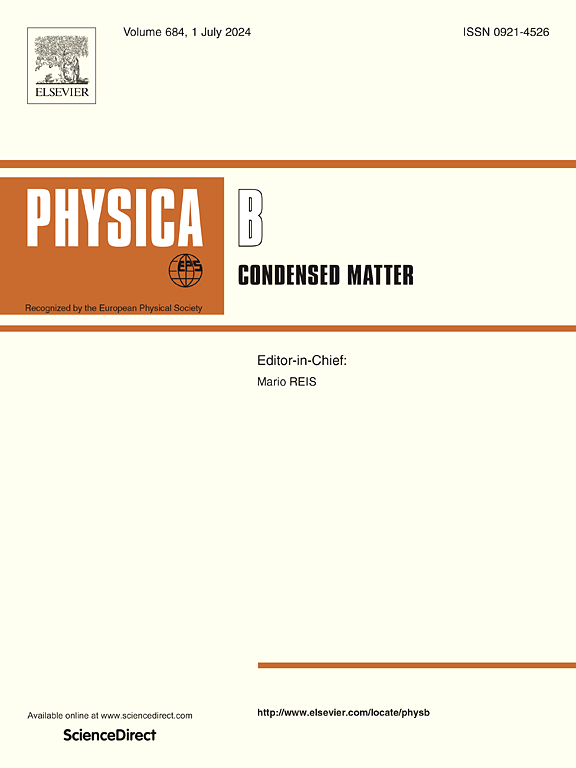石墨烯嵌入拓扑光子异质结构中的磁可调谐角不敏感多模吸收
IF 2.8
3区 物理与天体物理
Q2 PHYSICS, CONDENSED MATTER
引用次数: 0
摘要
本文研究了由级联TPC组成的石墨烯嵌入杂化一维拓扑光子晶体(TPC)异质结构中拓扑界面态(TISs)的角度不敏感多模吸收特性。利用由填充因子ρ定义的全介电椭圆超材料实现了TPC中产生的角不敏感光子带隙(PBG)。结合两种不同类型的TPC,即TPC1和TPC2,使TISs的角度不敏感激发,导致在界面上存在石墨烯时的角度不敏感吸收。为了实现多模吸收,将结构进一步级联,形成tpc1 -石墨烯- tpc2 -石墨烯- tpc1和tpc1 -石墨烯- tpc2 -石墨烯- tpc1 -石墨烯- tpc2等构型,分别表现为双模M2和三模M3吸收。外加磁场的施加和费米能级的变化显著提高了最大吸收,无论模式如何。本文章由计算机程序翻译,如有差异,请以英文原文为准。
Magnetically tunable angle-insensitive multimode absorption in graphene embedded topological photonic heterostrucures
This work examines the angle-insensitive multimode absorption characteristics of topological interface states (TISs) in a graphene-embedded hybrid one-dimensional (1D) topological photonic crystal (TPC) heterostructure composed of cascaded TPC. Angle-insensitive photonic bandgap (PBG), aroused in TPC, is achieved using the all-dielectric elliptical metamaterial defined by its filling factor, . Combining two different types of TPC i.e. TPC1 and TPC2, enables angle-insensitive excitation of TISs, leading to angle-insensitive absorption with the presence of graphene at the interface. To achieve multimode absorption, the structures are further cascaded, forming configurations such as TPC1-graphene-TPC2-graphene-TPC1 and TPC1-graphene-TPC2-graphene-TPC1-graphene-TPC2, which exhibit dual-mode, and triple-mode, absorption, respectively. The application of an external magnetic field and variation of Fermi level significantly enhances the maximum absorption, irrespective of the modes.
求助全文
通过发布文献求助,成功后即可免费获取论文全文。
去求助
来源期刊

Physica B-condensed Matter
物理-物理:凝聚态物理
CiteScore
4.90
自引率
7.10%
发文量
703
审稿时长
44 days
期刊介绍:
Physica B: Condensed Matter comprises all condensed matter and material physics that involve theoretical, computational and experimental work.
Papers should contain further developments and a proper discussion on the physics of experimental or theoretical results in one of the following areas:
-Magnetism
-Materials physics
-Nanostructures and nanomaterials
-Optics and optical materials
-Quantum materials
-Semiconductors
-Strongly correlated systems
-Superconductivity
-Surfaces and interfaces
 求助内容:
求助内容: 应助结果提醒方式:
应助结果提醒方式:


